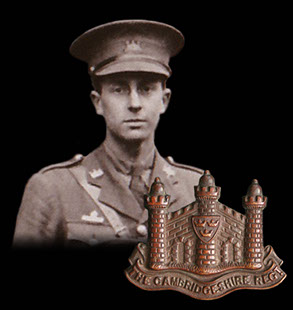Sir Conrad Lawrence Corfield MC
One of the many Cambridge University students who joined the Cambridgeshire Regiment, Conrad Corfield was awarded the Military Cross in 1916 and after the war rose to the top of the Indian Civil Service and was knighted.
Born in 1893 at Heanor, Derbyshire, he was the son of the Rev Egerton Corfield MA, (secretary of Church Mission Society at Cambridge, and later rector of Finchampstead, Berks) and Ethel Grace Corfield. Conrad went up to St Catharine’s College, Cambridge, in 1912 and gained a Blue for hockey
When war was declared he gained a commission in the Cambridgeshire Regiment as 2nd Lieutenant, going overseas with A Company, 1/1st Battalion, in February 1915. He was promoted to Lieutenant the following month and was invalided to England with trench fever in July.
Posted to the 3/1st Battalion for home service, he met Sir Theodore Morison, another Cambs Regiment officer and a member of Council of the Secretary of State for India, who encouraged Conrad to apply for the Indian Civil Service.
Promoted to Temporary Captain, he returned to the 1/1st Battalion in August 1916, being posted to B Company. His youngest brother Lt Hubert Vernon Anchital Corfield, 7th East Lancs, had been killed in July 1916. His eldest brother, Lt Egerton Anson Frederick Corfield, 153 Bty RA, was to die at Messines in 1917.
In August 1916, the Cambridgeshires had been moved to the Somme with the 39th Division. During an attack by another brigade of the division on September 3, 1916, the 1/1st Battalion had occupied the front line as the attacking troops advanced. The Cambridgeshires were subjected to an intense bombardment by the Germans, who also launched a counter-attack. Conrad was awarded a Military Cross for his actions and was wounded.
His MC citation reads: “He set a fine example when consolidating a trench under heavy shell fire. He also brought in a wounded man under broad daylight, and later was himself wounded in carrying out a dangerous patrol.”
In October he was appointed adjutant of the battalion. After the battalion’s part in the capture of the Schwaben Redoubt at Thiepval on October 14, he sustained shellshock when a shell hit the battalion HQ on October 15. He returned to duty the following day.
Invalided to England with a knee injury in May 1917, he was promoted to full Captain and seconded for service with an Officer Cadet Battalion. He officially left the army in 1920, joining the Indian Civil Service.
His first appointment was as an Assistant Commissioner, being promoted to Assistant Private Secretary to the Viceroy, Lord Reading, a post he held until the end of 1922, when he married Phyllis Bertha Pugh. They had two children.
He transferred to the Indian Political Service in 1923, returning to England in 1930 when his son was placed in prep school. Conrad returned as secretary at Hyderabad, then moved to Rewa. Phyllis had a hunting accident in 1932 so they returned to England, where she died in December 1932.
Conrad, who briefly played hockey for England, returned to India, transferring in 1934 to Political Department at Simla and Dehli. He was joint secretary to the Indian Government’s Foreign & Political Dept, in 1934, Officiating Political Secretary in 1937, Resident for Jaipur from 1938-40; Political Agent at Quetta in 1940, and Under-Secretary for the Punjab States 1941-45. He was awarded the Order of the Indian Empire (CIE) in 1937 and Companion of the Order of the Star of India (CSI) in 1942.
He became political adviser to the Viceroy, Lord Wavell, from April 1945 to 1947 and Mountbatten, the last Viceroy, in 1947.
Knighted as Knight Commander of the Order of the Indian Empire (KCIE) by the King in 1945, he would be known as the doyen of 20th century British political officers, being the last official head of the Indian Political Service. Sir Conrad wanted no part in Indian independence and returned to England in 1947, just two weeks after retiring. It is believed that the character of Sir Robert Conway in the acclaimed film ‘The Jewel in the Crown’ is based on Sir Conrad.
After returning home to live in Finchampstead, he considered standing for Parliament. He married Sylvia Phyllis Mary Daunt, widow of Lt-Col Charles O’Brien Daunt OBE, MC in 1961. She died in 1977 and Sir Conrad died in 1980, aged 87. He is buried at St James’ Church, Finchampstead.

Corfield in early 1915.

Corfield MC in 1917.

This site went live on the 14th February 2015 to mark 100 years since the 1/1st Cambs went off to war.
WE WILL REMEMBER THEM
Email us: cambsregt@gmail.com
Copyright 2015, 2016, 2017, 2018, 2019 by Felix Jackson. The information and images on this site should not be reproduced without prior permission.